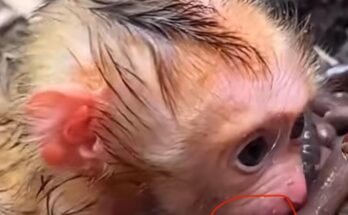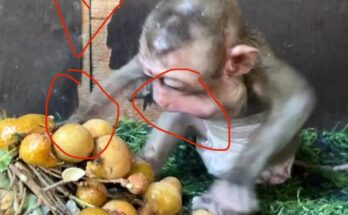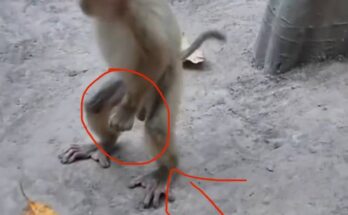
Monkeys are known for their expressive faces, and their reactions to tasting something sweet and cold are both funny and adorable. Some might lick carefully, savoring the flavor, while others might take big bites, shivering slightly from the chill but going right back for more. Their happiness is obvious—the wagging tails, the bright eyes, the playful chatter among the group. It’s a scene that fills the heart with joy, a reminder that even in the wild, animals experience moments of pleasure similar to our own.
But beyond the fun and laughter, feeding ice-cream to wild monkeys also raises some important questions. Is it really safe or healthy for them? What happens when wild animals get used to human food? While the act of sharing a treat comes from kindness, it’s essential to remember that ice-cream is not part of a monkey’s natural diet. It contains sugar, milk, and artificial flavors that can cause digestive issues or health problems for them over time. In the wild, monkeys thrive on fruits, leaves, nuts, and insects—foods that provide natural energy and nutrients. So, while a small lick of ice-cream might bring temporary happiness, regular feeding could make them dependent on humans for food, affecting their natural instincts and foraging habits.
Many wildlife experts suggest that instead of feeding human snacks, we can observe and appreciate animals from a respectful distance. If one truly wishes to share food, offering natural fruits like bananas, mangoes, or watermelon slices is a much healthier choice. These fruits are closer to what monkeys naturally eat and provide safe nourishment without harm. Still, there’s no denying that witnessing monkeys react to ice-cream can be an unforgettable moment—something that stays in one’s memory for years.
In many tourist destinations across Asia—especially in countries like India, Thailand, Cambodia, and Indonesia—wild monkeys are common near temples, forests, and parks. Tourists often feed them, sometimes for fun, sometimes out of compassion. Monkeys in these areas have learned to associate humans with food, and they often approach people confidently, sometimes even snatching treats right out of their hands. While this behavior can be entertaining, it’s also a reminder of how human actions shape animal behavior.
Feeding ice-cream to wild monkeys might look like a simple act of joy, but it symbolizes something deeper—the connection and curiosity between species. Humans have always been fascinated by animals that mirror parts of our own behavior, and monkeys, with their intelligence and playfulness, are among the closest examples. When a monkey takes an ice-cream cone and eats it just like a human child would, it’s almost impossible not to smile. In that moment, the boundaries between the wild and the civilized seem to fade.
However, every such experience should come with mindfulness. Respecting the natural diet and space of wildlife ensures their health and safety. It’s possible to enjoy the charm of wild monkeys without harming them—by photographing, observing, or simply admiring them in their natural environment. The laughter and happiness of monkeys enjoying ice-cream remind us of the joy found in simple moments, but they also teach us about responsibility and coexistence.
Ultimately, the happiness of the monkeys eating ice-cream is a mirror of human kindness and curiosity. It shows how animals can feel joy just as we do, and how even small interactions can bridge the gap between species. But it also reminds us that true compassion means caring for their well-being, not just their temporary pleasure. Whether it’s a scoop of ice-cream, a banana, or just a friendly wave, what matters most is the respect we show toward the animals that share our planet.


